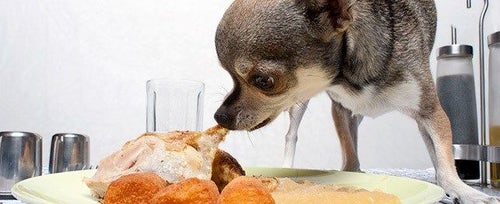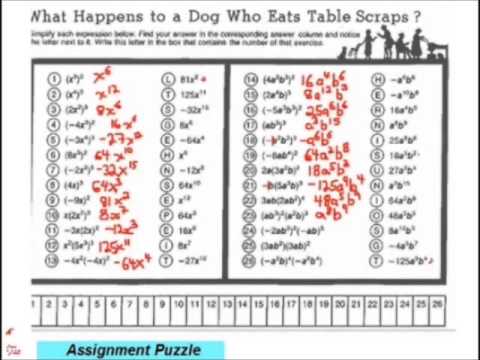When a dog eats table scraps, it can cause gastrointestinal upset and lead to obesity. Additionally, certain foods like chocolate, onions, and garlic are toxic to dogs and can be life-threatening if ingested.
Feeding table scraps can also reinforce begging behavior and contribute to poor nutrition. It’s important for pet owners to be mindful of their dog’s diet and only feed them appropriate, balanced meals to maintain their health and well-being. We’ll explore the potential consequences of feeding table scraps to dogs and provide guidance on creating a healthy diet for your furry friend.
We’ll also discuss safe and nutritious alternatives to table scraps that can keep your dog happy and healthy.

Credit: www.petplace.com
The Dangers Of Table Scraps For Dogs
Table scraps might seem like a harmless treat to share with your furry friend, but feeding your dog from your plate can actually pose several dangers to their health. It’s important to be aware of what kind of foods can be toxic for dogs and the potential digestive issues they may experience from consuming table scraps. By understanding these risks, you can ensure the well-being and safety of your beloved pet. Let’s explore the specific dangers in more detail.
Toxic Foods
Dogs may be eager to get their paws on any food that’s offered to them, but certain items commonly found in table scraps can be highly toxic to dogs. It’s crucial to be aware of these foods and resist the temptation to share them with your four-legged companion. Some examples of foods that can be harmful to dogs include:
- Chocolate
- Grapes and raisins
- Onions and garlic
- Avocado
- Alcohol
- Caffeine
- Nuts, especially macadamia nuts
- Xylitol (artificial sweetener)
These foods may contain substances that can lead to a range of symptoms, from mild discomfort to severe illness, or even death in some cases. It’s important to never underestimate the potential harm that these seemingly harmless scraps can cause to your pet.
Digestive Issues
Even foods that are not inherently toxic can still have adverse effects on a dog’s digestive system. Their bodies are not adapted to handle certain ingredients commonly found in human food, and consuming table scraps may result in various digestive issues. Some potential problems include:
- Upset stomach
- Vomiting
- Diarrhea
- Gas and bloating
- Pancreatitis (inflammation of the pancreas)
Dogs have different dietary requirements compared to humans, and sudden changes in their diet can disrupt the balance of their digestive system. This can lead to discomfort and potentially serious health issues. Additionally, certain spices and seasonings commonly used in human cooking can irritate a dog’s digestive tract, causing inflammation and further complications.
Therefore, it’s best to stick to a well-balanced, veterinarian-approved diet for your furry friend and avoid feeding them table scraps altogether. This will help to prevent any unnecessary risks and keep your dog happy and healthy.
Signs And Symptoms Of Table Scrap Consumption In Dogs
When dogs consume table scraps, it can lead to various signs and symptoms that indicate their discomfort. Keeping an eye on these indications can help you identify if your dog has ingested something they shouldn’t have. Here, we will delve into the specific signs and symptoms that can occur when a dog consumes table scraps.
Vomiting And Diarrhea
Dogs that have eaten table scraps may exhibit signs of vomiting and diarrhea. This can be a result of the digestive system reacting to the unfamiliar or fatty foods they have consumed. Vomiting can occur shortly after ingestion, while diarrhea may develop over a few hours or days. If you notice these symptoms, it’s crucial to monitor your dog’s condition closely and seek veterinary guidance if the symptoms persist.
Lethargy And Weakness
Lethargy and weakness can also manifest in dogs after consuming table scraps. This can be a result of the body’s reaction to processing and attempting to expel the ingested food. If your dog appears unusually fatigued or lacks their usual energy levels after ingesting table scraps, it’s important to pay close attention to their condition and consult with a veterinarian if these signs persist.
Health Risks Associated With Table Scrap Consumption
When dogs consume table scraps, they faces several potential health risks. It is essential for pet owners to understand the implications of feeding their dogs human food in order to prioritize their pet’s well-being.
Pancreatitis
Table scraps high in fat can lead to pancreatitis in dogs. This condition triggers inflammation of the pancreas, which can result in severe pain and discomfort for the pet. Rapid consumption of fatty foods can overload the pancreas, causing it to become inflamed and potentially leading to a life-threatening situation.
Obesity
Feeding dogs table scraps that are high in calories can easily lead to obesity. Obesity in dogs can cause a myriad of health issues, such as diabetes, joint problems, and decreased life expectancy. Dogs that regularly consume table scraps are at a higher risk of gaining excessive weight, especially if they do not receive enough exercise to burn off the additional calories.
Emergency Measures For Table Scrap Ingestion
Accidents happen, and sometimes our furry friends manage to gobble up those tempting table scraps when we’re not looking. While it may seem harmless, there are risks involved when a dog eats table scraps. In this blog post, we will explore the emergency measures you can take in such a situation. It is important to note that these measures should only be used in the case of immediate danger, and long-term prevention is always preferable.
Inducing Vomiting
If you catch your dog in the act, acting quickly is crucial. One of the first measures you can take is to induce vomiting. Please remember that this should only be done within the first two hours after ingestion and never if your dog has a history of health issues or has already begun to show symptoms of distress. To induce vomiting in your dog, follow these steps:
- Consult a Veterinarian: Contact your veterinarian immediately to seek their guidance and approval.
- Hydrogen Peroxide: Administer 1 teaspoon of 3% hydrogen peroxide per 10 pounds of your dog’s body weight (up to a maximum of 3 tablespoons) directly into their mouth using a syringe or turkey baster.
- Encouraging Movement: Gently exercise your dog by taking them for a short walk or playing fetch. This can help stimulate the vomiting reflex.
- Be Prepared: Have paper towels, gloves, and a cleaning solution at the ready to clean up after your dog vomits.
Seeking Veterinary Help
If inducing vomiting is not an option or your dog has already shown symptoms of distress, seeking immediate veterinary help is imperative. Your veterinarian will be able to provide proper guidance and treatment based on your dog’s specific condition.
- Don’t Delay: Contact your veterinarian right away for advice and to let them know you are bringing in your dog.
- Provide Details: Be prepared to provide information such as the type of food ingested, the quantity, and the time of ingestion.
- Observe Your Dog: Monitor your dog closely and note any changes in behavior, appetite, or symptoms they may exhibit. This information will be useful for the veterinarian.
- Follow Veterinary Instructions: Upon arrival at the veterinary clinic, follow their instructions and cooperate fully to ensure your dog receives the necessary care.
Remember, while emergencies can be stressful, it is essential to keep calm and take the appropriate measures to safeguard your dog’s health. However, always strive to prevent access to table scraps by properly disposing of them and reinforcing training to discourage this behavior.
Preventive Measures To Avoid Table Scrap Incidents
As responsible dog owners, it is crucial to take preventive measures to avoid table scrap incidents that could potentially harm our furry friends. Educating family members, practicing proper food disposal, and creating a safe feeding routine are important steps to keep our dogs healthy and happy.
Educating Family Members
Teaching everyone in the household about the dangers of feeding table scraps to dogs is essential. Many well-meaning family members may not realize that certain foods can be toxic to dogs. So, it’s important to educate them about which foods are off-limits, including chocolate, onions, grapes, and raisins. By raising awareness about the potential dangers, we can ensure that everyone is on the same page when it comes to feeding our furry friends.
Proper Food Disposal
When it comes to disposing of leftover food, it’s crucial to do so in a way that prevents dogs from getting their paws on it. Dogs are notorious for their scavenging abilities, so it’s essential to properly seal and store leftovers in containers that are inaccessible to our furry friends. In addition, ensure that garbage cans are securely closed and placed in areas that are not easily accessible to your dog. By practicing proper food disposal, we can minimize the risk of our dogs indulging in potentially harmful table scraps.
Creating A Safe Feeding Routine
Establishing a consistent feeding routine for our dogs can help prevent them from begging or attempting to steal food from the table. By providing regular and well-balanced meals in a calm and controlled environment, our dogs will be less inclined to seek out table scraps. Additionally, designating a specific feeding area for your dog can help reinforce the idea that they should only eat their own food. This routine will not only deter them from consuming table scraps but also ensure that they receive the nutrition they need from their designated meals.
By implementing these preventive measures, we can minimize the risks associated with dogs consuming table scraps. Educating family members about safe feeding practices, practicing proper food disposal, and establishing a safe feeding routine will contribute to the overall well-being and health of our furry friends.

Credit: www.slideshare.net

Credit: www.coursehero.com
Frequently Asked Questions For What Happens To A Dog Who Eats Table Scraps
What Are The Dangers Of A Dog Eating Table Scraps?
When a dog eats table scraps, it can lead to a variety of health issues. The food may be too high in fat, resulting in obesity. Certain foods can be toxic to dogs, causing gastrointestinal upset or even poisoning. It can also disrupt their balanced diet, leading to nutritional deficiencies.
What Are The Common Table Foods That Are Harmful To Dogs?
There are several common table foods that can be harmful to dogs. Chocolate, onions, garlic, and grapes/raisins are toxic and can cause serious health problems. Other foods like fatty meats, bones, coffee, alcohol, and high-salt foods should also be avoided as they can cause digestive and other health issues in dogs.
How Does Eating Table Scraps Affect A Dog’s Behavior?
Eating table scraps can lead to negative behaviors in dogs. They may become beggars, constantly seeking food during meal times. This can result in a lack of focus, obedience issues, and potential aggression when denied access to table scraps. It’s important to discourage this behavior to maintain a well-behaved dog.
Conclusion
Feeding table scraps to your dog can have potential health consequences, including digestive problems, weight gain, and nutritional deficiencies. It is best to avoid giving your dog human food and stick to a balanced and nutritious diet designed specifically for them.
By taking good care of your pet’s diet, you can ensure their overall well-being and prevent any unnecessary health issues. Remember, a healthy dog is a happy dog!



